Going Glutton
Singapore is for Foodies. I’m no a professional, but I know what tastes good. And for me, Asian food is at the top of the heap. If naturally follows that Singapore would give me culinary opportunities I could not pass up.
I’ve already written about my chili crab experience, a night of fine dining that delivered a great introduction to local cuisine. But the real deal, the tried and true, the nitty and the gritty, is the street food. Scattered across Singapore are food courts called hawker centers, where stall after stall delivers fresh flavors from around the world. I’m staying in Little India, where the Tekka Centre serves up a hectic mix of Indian and Muslim dishes. The Maxwell Road Food Centre in Chinatown is the place for Chicken Rice (not Chicken and Rice, just Chicken Rice). There’s also the Adam Road Food Centre, Chomp Chomp and Lau Pa Sat. This doesn’t even take into account food courts in the basement of every shopping mall and the restaurants tucked into residential neighborhoods and lining the ground floors of housing complexes.
 How am I, a stranger to this country, supposed to navigate this cornucopia of cuisine? That’s where Makansutra comes in. Think Zagat, same basic shape and size, but instead of restaurants, Makansutra points diners toward street food. At less than $10 U.S., the guide is a worthy investment even for a short stay in Singapore. The book contain an alphabetical list of dishes, from Abacus Seeds (“yam flour cakes”) to Yong Tau Foo (“a Hakka meal of tofu stuffed with mixed meat or fish patties”), with short descriptions of each dish followed by the best places to consume them. Each eatery is graded on a chopstick scale: one pair is “Good,” three pairs “Die, die must try!” The book even tags local specialties with a blue dot and the text “Popular Local Favorite.”
How am I, a stranger to this country, supposed to navigate this cornucopia of cuisine? That’s where Makansutra comes in. Think Zagat, same basic shape and size, but instead of restaurants, Makansutra points diners toward street food. At less than $10 U.S., the guide is a worthy investment even for a short stay in Singapore. The book contain an alphabetical list of dishes, from Abacus Seeds (“yam flour cakes”) to Yong Tau Foo (“a Hakka meal of tofu stuffed with mixed meat or fish patties”), with short descriptions of each dish followed by the best places to consume them. Each eatery is graded on a chopstick scale: one pair is “Good,” three pairs “Die, die must try!” The book even tags local specialties with a blue dot and the text “Popular Local Favorite.”
I’m a slave to guidebooks. I like orderly sources of information, anything that can send me in the right direction, and in the past few days Makansutra has become a vital tool, almost a trusted friend.
But let me back up a step. After gorging on Chili Crab, and still undecided on the Makansutra guide, I did a little online research and decided my next meal had to be Chicken Rice, considered to be Singapore’s national dish. From Makansutra: “Rice grains are fried in garlic, sesame and chicken oils before boiling in chicken stock. The fowl is boiled, then dunked in cold water or ice to smoothen out the skin and gelatinize the oils. The sliced chicken is served with a plate of tasty rice with cucumbers and a tangy chili dip, ginger sauce and dark soy sauce.” Sounds delicious, no?
Two more trusted sources, Anthony Bourdain and Michael Y. Park, agreed that the best place for Chicken Rice is in the Maxwell Road Food Centre, stall number 10, Tian Tian Hainanese Chicken Rice. To my astonishment, the stall was closed when I arrived, a note tacked to the shutter announcing that Tian Tian was in New York City to serve Chicken Rice at Singapore Day. The irony was not lost on me. (They are open again for business and I will try Tian Tian Chicken Rice before I leave.) I ended up the dish at another stall and found the cold chicken refreshing given Singapore’s hot and humid climate. The tangy ginger and the spicy chilies complemented the plain strips of boiled fowl.
Chicken Rice was my last meal without a guide. Armed with Makansutra, I set out the next day determined to try as many local favorites as possible.
My first stop, on Friday, was Chap Chye Rice at Loo’s Hainanese Curry Rice. There’s not much to curry rice. You slop some rice on plate, choose from an assortment of meat and vegetable dishes and slather it all with starchy curry gravy.
I quickly discovered that while English is the official language of Singapore, my culinary travels were going to take me into neighborhoods where English is the second, even third or fourth, language. I would have to rely on pointing and nodding. At Loo’s, I waited in line (if there’s a line at a food stall, eat there, say the locals) and when my turn came I pieced together meal of steamed rice, fried tofu, stringy greens and a breaded pork cutlet, all topped with a tangy curry gravy. The plate contained more grease than I wanted, but the gravy was spicy and thick, the pork juicy on the inside with a flaky crust. I don’t think I’d rate it three chopsticks. Still, I’m an amateur and accepted my meal with grace.
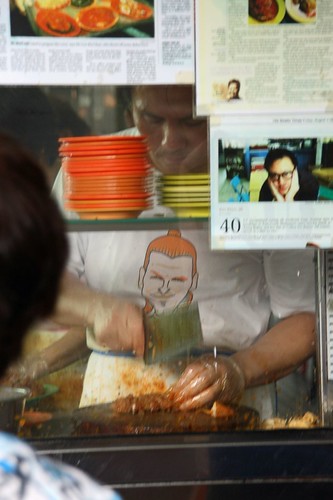
The Counter at Loo's
Next, I decided next to branch out, to take a risk, to face a dish that in most circumstances would elicit a long, drawn out “eewwwwww” at the mention of its name: Fish Head Curry. Makansutra: “A whole huge snapper head, complete with lips, eyes and cheeks is cooked in a spicy, tangy, tamarind curry with okra and tomatoes. Some say it is a uniquely Singaporean creation, when Gomez, an Indian cook decided to cook the fishheads which were thrown away.” Apart from the tortured punctuation, this is an accurate description of the dish.
Most street food in Singapore will set you back no more than five bucks (current exchange rate is about U.S$1 to S$1.50). Fish Head Curry is another matter – at the Banana Leaf Apollo in Little India I paid S$18 for a small fish head. Nevertheless, I was served a massive snapper head drowning in a sea of delicious curry, with steamed rice, a pile of steamed cabbage, chutney and papadum on the side. The dish should be called Fish Head and Neck Curry because the majority of the edible white flesh comes from what would be the neck and shoulders if fish had necks and shoulders. I was surprised by the amount of meat in the dish. And hidden in the curry sauce were tender stalks of okra and sweet chunks of pineapple.
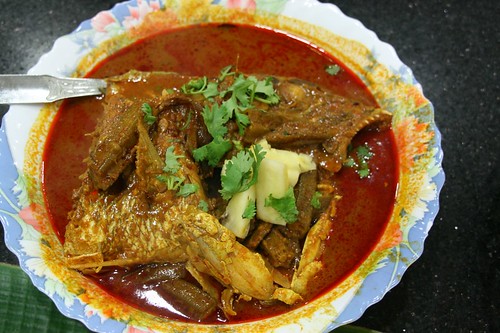
Fish Head Curry
Remember my description of eating Chili Crab? Repeat, substituting Fish Head Curry for Chili Crab. The Banana Leaf is an Indian restaurant, so I ate with my right hand, shoveling morsel after morsel of fish into my mouth until there was nothing left but a carcass, one eyeball falling out of the socket. I’m sure some people eat the eyes; I’ll climb that mountain another day.
Saturday dawned and with an empty stomach I wanted to eat through the weekend. But I had made plans with Margie, an eclectic Australian (and self-proclaimed dreamer and visualization acrobat), to spend the afternoon at the Singapore Botanic Gardens. We had fun with the flowers, especially those at the National Orchid Garden, but you can’t eat orchids and I didn’t get back on the Makansutra trail until dinner.
I chose a South Chinese Teochoew dish called Bak Chor Mee: “Minced pork, sliced mushrooms, fishcakes and meat dumplings sit on top of noodles tossed in a special chili sauce with a hint of vinegar. You can order it ‘dry,’ with the noodles and soup segregated, or get the all-in-one meaty soup version.”
At this point you are saying, “Matt doesn’t know a thing about South Chinese Teochow cuisine.” Guilty as charged. I’m an ignoramus. I chose Bak Chor Mee because it is a local favorite and would take me into a part of town where I would see no other tourists. One of the joys of travel for me is nosing around where the locals live. Loo’s, where I ate Curry Rice, is in a residential neighborhood of modest apartment buildings (80 percent of Singaporeans live in government subsidizes housing) outside of the area covered by my tourist map. Bak Chow Mee would take me into a real neighborhood once again.
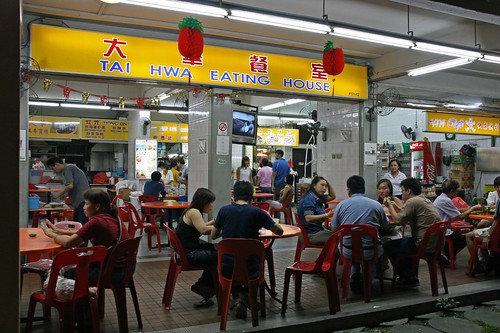
Tai Hwa Eating House
I was not only the only white guy at Hill Street Tai Hwa Pork Noodles off North Bridge Road, it seemed like I was the only white guy in town. Tai Haw is one stall in a tiny “Eating House” in a housing complex. Finding the address, “Block 466, #01-12,” was a challenge. But I’m persistent and once I arrived I knew I was in the right place because of the line snaking from the counter. Again, trust the locals.
I queued up, waited for an eternity, and was offered translation services by a nice elderly woman at the front of the line. I wanted the “dry” version of Bak Chor Mee, but ended up with the soup. Think ramen, with flat noodles and a stock made from vinegar and soy. Sprinkled throughout were bits of meat: minced pork, liver slices, a meatball from an unknown animal and fingernail-sized bits of dried fish, each ingredient added raw to the bowl and cooked by the boiling broth. There was also a mass of fungus I assumed to be the sliced mushrooms. An earthy odor arose from the bowl, the fungus and liver most prominent, but with a hint of the sweet vinegar and chilies.
The Bak Chor Mee was exquisite. And I had the realization while slurping the noodles and gingerly testing a fish bit, that often the difference between good food and excellent food is often nothing more than a clean feeling while I’m eating. This dish could have been oily, it could have been overpowered by the meat, the flavor of the tender noodles pummeled by the stronger ingredients, but the flavors were in perfect harmony, each nugget delivering a unique taste while the subtle broth unified the dish into something whole.
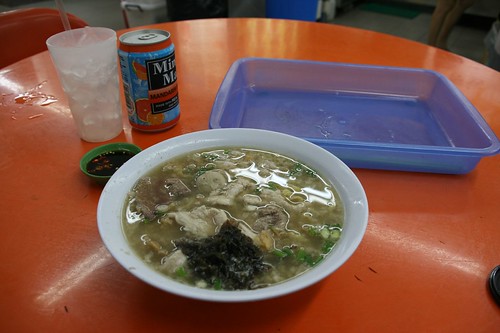
Bak Chor Mee, the Wet Version
I am not a food writer. I would prefer to write about the experience of eating than the flavors I encounter. How do I explain what’s it like to taste a new mushroom? Are there words to describe a fishball (spongy and delicious don’t cut it)? As I continue to eat my way through Singapore, I’ll share my impressions. I hope you’ll enjoy this food for thought (bad pun, I’m sorry), but recommend you get your empty stomach to Singapore and try it yourself.
I’ve already written about my chili crab experience, a night of fine dining that delivered a great introduction to local cuisine. But the real deal, the tried and true, the nitty and the gritty, is the street food. Scattered across Singapore are food courts called hawker centers, where stall after stall delivers fresh flavors from around the world. I’m staying in Little India, where the Tekka Centre serves up a hectic mix of Indian and Muslim dishes. The Maxwell Road Food Centre in Chinatown is the place for Chicken Rice (not Chicken and Rice, just Chicken Rice). There’s also the Adam Road Food Centre, Chomp Chomp and Lau Pa Sat. This doesn’t even take into account food courts in the basement of every shopping mall and the restaurants tucked into residential neighborhoods and lining the ground floors of housing complexes.
 How am I, a stranger to this country, supposed to navigate this cornucopia of cuisine? That’s where Makansutra comes in. Think Zagat, same basic shape and size, but instead of restaurants, Makansutra points diners toward street food. At less than $10 U.S., the guide is a worthy investment even for a short stay in Singapore. The book contain an alphabetical list of dishes, from Abacus Seeds (“yam flour cakes”) to Yong Tau Foo (“a Hakka meal of tofu stuffed with mixed meat or fish patties”), with short descriptions of each dish followed by the best places to consume them. Each eatery is graded on a chopstick scale: one pair is “Good,” three pairs “Die, die must try!” The book even tags local specialties with a blue dot and the text “Popular Local Favorite.”
How am I, a stranger to this country, supposed to navigate this cornucopia of cuisine? That’s where Makansutra comes in. Think Zagat, same basic shape and size, but instead of restaurants, Makansutra points diners toward street food. At less than $10 U.S., the guide is a worthy investment even for a short stay in Singapore. The book contain an alphabetical list of dishes, from Abacus Seeds (“yam flour cakes”) to Yong Tau Foo (“a Hakka meal of tofu stuffed with mixed meat or fish patties”), with short descriptions of each dish followed by the best places to consume them. Each eatery is graded on a chopstick scale: one pair is “Good,” three pairs “Die, die must try!” The book even tags local specialties with a blue dot and the text “Popular Local Favorite.”I’m a slave to guidebooks. I like orderly sources of information, anything that can send me in the right direction, and in the past few days Makansutra has become a vital tool, almost a trusted friend.
But let me back up a step. After gorging on Chili Crab, and still undecided on the Makansutra guide, I did a little online research and decided my next meal had to be Chicken Rice, considered to be Singapore’s national dish. From Makansutra: “Rice grains are fried in garlic, sesame and chicken oils before boiling in chicken stock. The fowl is boiled, then dunked in cold water or ice to smoothen out the skin and gelatinize the oils. The sliced chicken is served with a plate of tasty rice with cucumbers and a tangy chili dip, ginger sauce and dark soy sauce.” Sounds delicious, no?
Two more trusted sources, Anthony Bourdain and Michael Y. Park, agreed that the best place for Chicken Rice is in the Maxwell Road Food Centre, stall number 10, Tian Tian Hainanese Chicken Rice. To my astonishment, the stall was closed when I arrived, a note tacked to the shutter announcing that Tian Tian was in New York City to serve Chicken Rice at Singapore Day. The irony was not lost on me. (They are open again for business and I will try Tian Tian Chicken Rice before I leave.) I ended up the dish at another stall and found the cold chicken refreshing given Singapore’s hot and humid climate. The tangy ginger and the spicy chilies complemented the plain strips of boiled fowl.
Chicken Rice was my last meal without a guide. Armed with Makansutra, I set out the next day determined to try as many local favorites as possible.
My first stop, on Friday, was Chap Chye Rice at Loo’s Hainanese Curry Rice. There’s not much to curry rice. You slop some rice on plate, choose from an assortment of meat and vegetable dishes and slather it all with starchy curry gravy.
I quickly discovered that while English is the official language of Singapore, my culinary travels were going to take me into neighborhoods where English is the second, even third or fourth, language. I would have to rely on pointing and nodding. At Loo’s, I waited in line (if there’s a line at a food stall, eat there, say the locals) and when my turn came I pieced together meal of steamed rice, fried tofu, stringy greens and a breaded pork cutlet, all topped with a tangy curry gravy. The plate contained more grease than I wanted, but the gravy was spicy and thick, the pork juicy on the inside with a flaky crust. I don’t think I’d rate it three chopsticks. Still, I’m an amateur and accepted my meal with grace.

Next, I decided next to branch out, to take a risk, to face a dish that in most circumstances would elicit a long, drawn out “eewwwwww” at the mention of its name: Fish Head Curry. Makansutra: “A whole huge snapper head, complete with lips, eyes and cheeks is cooked in a spicy, tangy, tamarind curry with okra and tomatoes. Some say it is a uniquely Singaporean creation, when Gomez, an Indian cook decided to cook the fishheads which were thrown away.” Apart from the tortured punctuation, this is an accurate description of the dish.
Most street food in Singapore will set you back no more than five bucks (current exchange rate is about U.S$1 to S$1.50). Fish Head Curry is another matter – at the Banana Leaf Apollo in Little India I paid S$18 for a small fish head. Nevertheless, I was served a massive snapper head drowning in a sea of delicious curry, with steamed rice, a pile of steamed cabbage, chutney and papadum on the side. The dish should be called Fish Head and Neck Curry because the majority of the edible white flesh comes from what would be the neck and shoulders if fish had necks and shoulders. I was surprised by the amount of meat in the dish. And hidden in the curry sauce were tender stalks of okra and sweet chunks of pineapple.

Remember my description of eating Chili Crab? Repeat, substituting Fish Head Curry for Chili Crab. The Banana Leaf is an Indian restaurant, so I ate with my right hand, shoveling morsel after morsel of fish into my mouth until there was nothing left but a carcass, one eyeball falling out of the socket. I’m sure some people eat the eyes; I’ll climb that mountain another day.
Saturday dawned and with an empty stomach I wanted to eat through the weekend. But I had made plans with Margie, an eclectic Australian (and self-proclaimed dreamer and visualization acrobat), to spend the afternoon at the Singapore Botanic Gardens. We had fun with the flowers, especially those at the National Orchid Garden, but you can’t eat orchids and I didn’t get back on the Makansutra trail until dinner.
I chose a South Chinese Teochoew dish called Bak Chor Mee: “Minced pork, sliced mushrooms, fishcakes and meat dumplings sit on top of noodles tossed in a special chili sauce with a hint of vinegar. You can order it ‘dry,’ with the noodles and soup segregated, or get the all-in-one meaty soup version.”
At this point you are saying, “Matt doesn’t know a thing about South Chinese Teochow cuisine.” Guilty as charged. I’m an ignoramus. I chose Bak Chor Mee because it is a local favorite and would take me into a part of town where I would see no other tourists. One of the joys of travel for me is nosing around where the locals live. Loo’s, where I ate Curry Rice, is in a residential neighborhood of modest apartment buildings (80 percent of Singaporeans live in government subsidizes housing) outside of the area covered by my tourist map. Bak Chow Mee would take me into a real neighborhood once again.

I was not only the only white guy at Hill Street Tai Hwa Pork Noodles off North Bridge Road, it seemed like I was the only white guy in town. Tai Haw is one stall in a tiny “Eating House” in a housing complex. Finding the address, “Block 466, #01-12,” was a challenge. But I’m persistent and once I arrived I knew I was in the right place because of the line snaking from the counter. Again, trust the locals.
I queued up, waited for an eternity, and was offered translation services by a nice elderly woman at the front of the line. I wanted the “dry” version of Bak Chor Mee, but ended up with the soup. Think ramen, with flat noodles and a stock made from vinegar and soy. Sprinkled throughout were bits of meat: minced pork, liver slices, a meatball from an unknown animal and fingernail-sized bits of dried fish, each ingredient added raw to the bowl and cooked by the boiling broth. There was also a mass of fungus I assumed to be the sliced mushrooms. An earthy odor arose from the bowl, the fungus and liver most prominent, but with a hint of the sweet vinegar and chilies.
The Bak Chor Mee was exquisite. And I had the realization while slurping the noodles and gingerly testing a fish bit, that often the difference between good food and excellent food is often nothing more than a clean feeling while I’m eating. This dish could have been oily, it could have been overpowered by the meat, the flavor of the tender noodles pummeled by the stronger ingredients, but the flavors were in perfect harmony, each nugget delivering a unique taste while the subtle broth unified the dish into something whole.

I am not a food writer. I would prefer to write about the experience of eating than the flavors I encounter. How do I explain what’s it like to taste a new mushroom? Are there words to describe a fishball (spongy and delicious don’t cut it)? As I continue to eat my way through Singapore, I’ll share my impressions. I hope you’ll enjoy this food for thought (bad pun, I’m sorry), but recommend you get your empty stomach to Singapore and try it yourself.

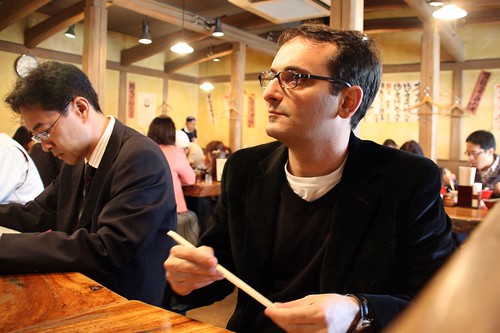

3 Comments:
I owe you $0.50 for the product placement when you get back.
No problem, Mr. Bourdain. Just put the check in the mail.
Who knows where to download XRumer 5.0 Palladium?
Help, please. All recommend this program to effectively advertise on the Internet, this is the best program!
Post a Comment
<< Home